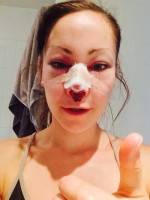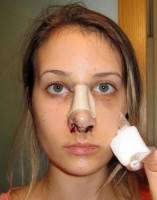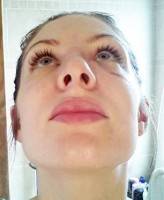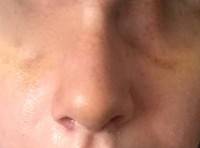Swelling After Rhinoplasty
Rhinoplasty – Nasal Surgery and Bruising, Edema (Swelling) after surgery
There are many different variations of a standard rhinoplasty. The surgery can entail correction of the nasal bones, the cartilage, the septum, the mucosa, the skin, the nostrils, and the nasal tip, just to name a few.
The more corrective the rhinoplasty procedure, the more edema and bruising you will get. The swelling is also highly dependent on how difficult and time consuming the surgery was prior to placing a nasal splint.
In most cases, a rhinoplasty procedure consists of an osteotomy of the nasal bones, correction of the dorsum or hump, and improvement of the nasal tip. In this case, the bruising and swelling is moderate and should last 5 days with a splint. There is residual swelling that is minor and will last over one year at times.
In order to reduce bruising and swelling after nasal surgery, consider sleeping with your head elevated after surgery, minimizing activities, and avoidance of aspirin or ibuprofens. (Raffy Karamanoukian, MD, FACS, Los Angeles Plastic Surgeon)
Swelling after rhinoplasty
The general rule of thumb for resolution of rhinoplasty swelling is the following: 80% reduction of swelling within 6 weeks 90% reduction within 6 months 100% reduction within 1 year.
Although this serves as a good rule of thumb, it is important to remember that there is interpersonal variation. Some patients have very little swelling, and some have tremendous swelling that lasts a long time.
Observations of patients with previous rhinoplasty has also demonstrated that some patients may have ongoing changes in their nasal appearance for several years after surgery.
Many factors are involved, including:
- Skin thickness
- Method or approach to rhinoplasty (open vs closed) – there is generally slightly greater swelling with open procedures
- Use of grafts during surgery
- Co-existing medical conditions
- Tendency to scar
- Infection, or blood clots underneath the skin
- Revision vs. primary – revision rhinoplasty often leads to greater and longer lasting swelling
My staff and I have observed decreased swelling, faster resolution of swelling and bruising with use of arnica montana (homeopathic medicine available over the counter), which we provide to all of our patients to begin before and after surgery. (Behrooz Torkian, MD, Beverly Hills Facial Plastic Surgeon)
Swelling after rhinoplasty surgery
Recovery after rhinoplasty will vary based on the person, characteristics of the nasal tissues and what was done during surgery.
At 3 weeks recovery, you are still very early in your recovery; your nose will still be swollen but many changes in shape should still be obvious to you. Around the 4-6 week mark, most patients are able to appreciate most of the changes from surgery as a significant amount of swelling has resolved.
However, it can take somewhere in and around 12-18 months to see the final results. Subtleties in tip shape and definition can take about 1 year to fully appreciate. The areas with thicker skin in the nose such as the tip, alar rims (the skin on the outside of the nostrils) and radix (the transition point between the forehead and nose) may require longer to settle.
Also there appears to be a linear decrease in swelling for the first several months followed by a period where the swelling fluctuates (sometimes little or no swelling and other times more swelling) before the nose settles. Again, after 4-6 weeks, although you will continue to notice changes in your nose, they are subtle and imperceptible to most other people. (Jamil Ahmad, MD, Toronto Plastic Surgeon)
Rhinoplasty Swelling Takes Time to Resolve
Swelling after rhinoplasty surgery is somewhat dependent on your skin thickness and condition prior to surgery. Patients with thin skin have their swelling resolve more quickly. Thicker or more oily skin tends to stay swollen longer. The more involved the procedure, the longer swelling will persist. On average, about 30-35% of the swelling resolves at about 3 weeks. At about 3 months about 60-65 % of the swelling is gone, The remaining swelling takes about 12-18 months to resolve. Each week and each month will be better. Avoid strenuous exercise, hot weather and hot showers to avoid increases in swelling. In oily skin, RetinA can help shrink the sebaceous glands. Taping of the supratip region can also be beneficial in some patients. Consider discussing your concerns further with your surgeon. (George Bitar, MD, Fairfax Plastic Surgeon)
In the majority of cases the average uninformed person will not realize an individual had rhinoplasty surgery within 3 weeks of a surgery.
Depending on whether tip work is done and the extent of the procedure, it can take a full year for the swelling to resolve. Luckily, most is gone in 3 to 6 months.
Studies have shown that even subtle changes occur in the operated nose over the ensuing 5 years.
The key is to have your nasal surgery by an experienced rhinologist/ facial plastic surgeon so to minimize undesirable results. (Lee Kleiman, MD, Annapolis Facial Plastic Surgeon)
Majority of the swelling goes away after a couple of months usually. It is totally normal to still have some swelling at three weeks.
Some of the nose swelling will persist, and take about a year to gradually go away. (Stella Desyatnikova, MD, Seattle Facial Plastic Surgeon)
Swelling after rhinoplasty
You probably should have some nose swelling three weeks after your rhinoplasty. Swelling after surgery depends upon what is done (how extensive), the amount of bruising (more bruising = more swelling), your body response (you cannot control), and your activity after surgery (more active = more swelling).
Most swelling of the nose will be gone within 3-6 weeks, but swelling of the tip may last a year or more. Your surgeon can tell you if your swelling is unusual, however. (Randy J. Buckspan, MD, Austin Plastic Surgeon)
Nose swelling after Rhinoplasty surgery improves in stages and depends on the extent of the surgery and the technique used. Most open rhinoplasties have more tip swelling when compared to closed techniques but the differences even out after three months. It is most important to follow up with your surgeon and review your post operative instructions. (James Newman, MD, Bay Area Facial Plastic Surgeon)
Nose swelling after rhinoplasty may last up to one year and beyond. The key is to know that. Your physician should tell you that the swelling is part of the recovery and that it will subside. Sometimes the swelling persists and you may need a small amount of steroid injections to hurry it along. You will see a difference with your nose right away but be patient. After about 6 weeks your swelling will get better. (Carlos Wolf, MD, Miami Facial Plastic Surgeon)
Nose Swelling after Rhinoplasty may last 1 to 12 months
Post – Rhinoplasty nasal swelling lasts up to 1-12 months in some form. However, while you SHOULD STILL have nasal swelling 3 weeks after your surgery it should not be extreme. You may want to check with your surgeon. (Peter A. Aldea, MD, Memphis Plastic Surgeon)
Lengh of swelling after rhinoplasty
The duration of swelling after is related to the magnitude of the surgery. The typical length is 12-18 months. Activity should be curtailed in the early weeks to minimize compounded swelling. (Rodger Wade Pielet, MD (in memoriam), Chicago Plastic Surgeon)
Can last up to 1 years time. 3 weeks is very early in the scheme of things. Most patients achieve a nice result at about 6 months were there is minimal swelling but ultimately it will take 1 years time before all the swelling is gone. (Farbod Esmailian, MD, Orange County Plastic Surgeon)
It is normal to have swollen nose at 3 weeks after surgery. However how swollen you are depends greatly on how much surgery you had done. If the procedure was done (open) or an external approach with an incision in the columella ( the skin between the nostrils) then it is likley you will be swollen for longer. Likely you will have a nice result it will just take longer for it to be apparent. If your procedure was done closed (incisions on the inside) then likley you will have less swelling and sooner will appreciate the imporvement.
Consider steroid injections which can be helpful if done judiciously or consider taping your nose at night with paper tape. Both of these interventions may be helpful to reduce the appearance of swelling but be sure to check with your surgeon first. Some believe a low salt (sodium) diet is helpful but I have not found this important. Consider warm compresses and ultrasound facials which may slightly help with lymphatic edema (swelling). Likely you will just have to give it some more time. (Steven H. Dayan, MD, Chicago Facial Plastic Surgeon)



